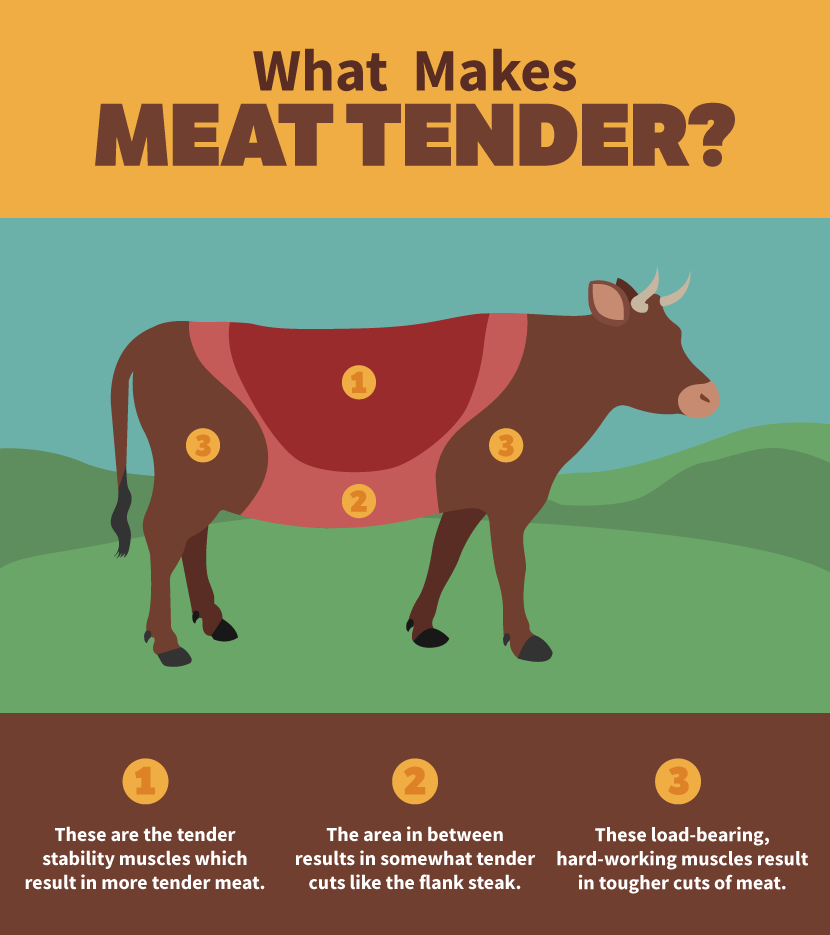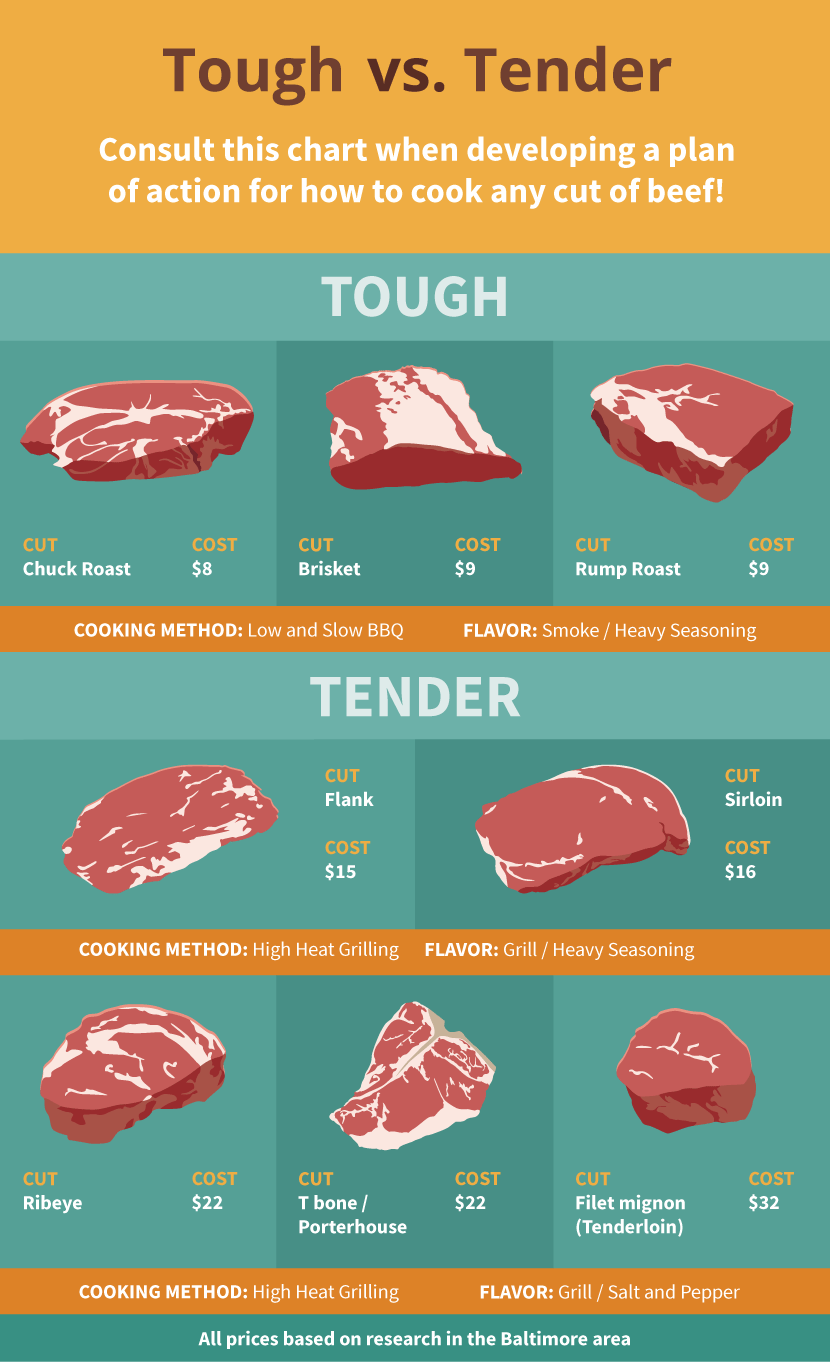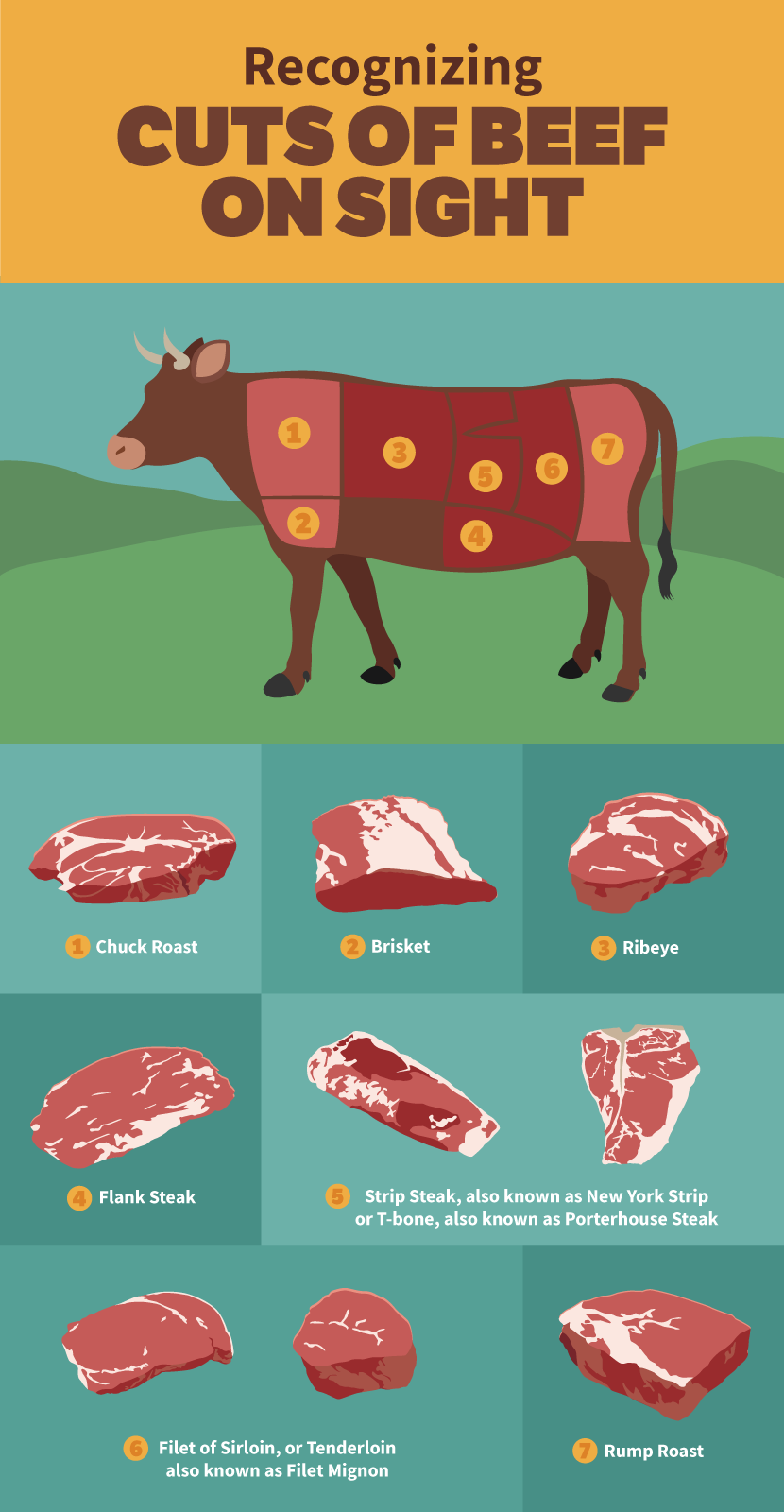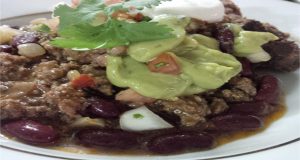Written by John Thomas
Have you ever walked through the meat section of a grocery store or butcher shop and gotten lost in the endless choices of steak that are presented to you? Most people do, so don’t feel bad. It’s not so tricky to figure it out once you have a good understanding of the common steak cuts and where they come from on the cow. The first thing to understand is that, in general, a more tender cut of meat will come from an area of the cow that is non-weight-bearing. This would be a muscle area that doesn’t do most of the heavy work involved in walking and, as a result, has much less tough connective tissue. Now, as you’ll see, the cooking method and other factors have a major role in the tenderness of the steak, but in general a heavily used muscle region (locomotion and weight support) will be tougher than one that is used for cow posture and stability, which are the most tender cuts.
Lucky for us, just because a cut of meat comes from a certain area of a cow doesn’t necessarily mean it will be tough and chewy solely based on muscle workload and tissue composition. Cooking method, among other things, plays a major role in this. As an example of cooking method and meat toughness, when we think of southern American barbecue, we immediately think of extremely tender meat that falls apart, hence the “pulled” in pulled pork or pulled beef. However, these cuts of meat are inherently tough and full of tough connective tissue. It is widely believed that back in the day of slaves and Southern plantations, tough cuts of meat were all that were available to slaves and they utilized “low and slow” cooking methods to make these tough cuts extremely tender and enjoyable. This sets us up for the important concept that any meat can become tender if you cook it appropriately. The naturally tender cuts of meat can be grilled quickly at high heat for a luxuriously decadent steak without much work. However, this results in a higher price per pound of meat. A naturally tough cut of meat will be much cheaper per pound, but in order to end up with tender meat you might need to smoke it at low temperatures for about 12 hours, which is a lot of work.
Grilling
As discussed, an inherently tender steak can be high-heat-seared on a grill. The steak can be cut thick, and after grilling it will be extremely tender. Think of the thick filet mignon steak that comes from the beef tenderloin. This is one of the stability or posture muscles, and it will have less connective tissue and be more marbled with fat. It will be the most expensive cut at about $32 per pound, per a recent glance at my butcher’s pricing. My personal preference for flavoring a succulent cut like this is simply salt and pepper, so the natural beef flavor shines through. The same applies to the porterhouse and T-bone steaks, both of which are located in that tender region of the cow and come in at about $22 per pound.
Now, if budget is an issue and you want to grill a cheaper cut of steak, your best bet will be to grill a thinner cut like the flank steak, which will set you back about $15 per pound. This muscle is used much more by the cow (lower abdominal muscle) and will have more connective tissue and be tougher. To get around this, this cut of meat is commonly sliced thin and used in meals like steak fajitas with a heavy marinade, to help further tenderize the meat. Lots of seasoning provides a better eating experience, since tenderness is compromised. To take this one step further, hamburger meat is usually made up of cheaper tough cuts of meat that are ground. The act of grinding the meat significantly improves tenderness, and is why the hamburger is so popular at tailgates and cookouts. Ground beef is generally in the range of $2 to $6 per pound, depending on what type of meat was ground and where you are shopping.
Low-and-Slow Barbecue
To get more bang for your buck with the tougher cuts of beef, the preferred method is to cook it low and slow. Some articles discuss braising the meat, but since I’m a grilling guy I prefer low-and-slow barbecue smoking. It accomplishes the same thing as braising, but your meat will taste like smoky goodness rather than the flavorless pot roast we know from growing up. Chuck roasts and briskets are extremely tough cuts that are full of connective tissue. Tossing these on the grill will result in some unhappy cookout guests, as they’d be chewing for most of the time. However, if the meat is slow-cooked for about 10-12 hours at 250 degrees F, give or take, the connective tissue essentially melts and the meat becomes tender and succulent and will fall apart.
Brisket is the hallmark of Texas-style barbecue. The brisket is a massive muscle and comes from the chest region of the animal. This muscle supports most of the cow’s weight and, as such, is loaded with tough connective tissue. My butcher has briskets going for about $9 a pound, much less than the succulent tenderloin discussed above ($32 per pound). Similarly, a rump roast (about $8 a pound), which is a major component of the rear leg muscles, is as tough as can be, unless it is cooked low and slow for an extended period of time. A rump roast or a chuck roast can be used for pulled barbecue beef (think pulled pork, but beef).
The flavoring for these cuts is really a personal decision. Commonly, a flavorful and spicy barbecue rub is used to coat these tougher cuts of meat; however, one major exception is Texas brisket, where a simple salt-and-pepper seasoning is all that is needed in that part of the country. The flavor from the smoke and the tenderness that results from the pit master’s work makes this rival even the best filet mignon. However, a lot of work is required.
Now when you are walking through the grocery store or butcher, I hope that you will be a bit more familiar with what is going on. Take a look at the fat marbling and thickness of the steak. Chances are, the more internal fat marbling, the higher the price per pound will be (USDA Prime meats are often more highly marbled, making them even more tender than the other lower-priced USDA classifications such as “choice” or “select”). These cuts with more fat marbling are the more tender cuts that you can toss on the grill and have a high-end steak experience.
A leaner cut, on the other hand, might be on the cheaper side, as it might require a marinade or a heavier seasoning and thin slicing to make it work (steak fajitas). A large lean roast with less fat will also be on the cheaper side, as it will require much more work (low-and-slow smoking) by the cook to create a tender, succulent meal.
Surely, as with any discussion, there are lots of variables to meat selection and tenderness. But this guide should get you off and running on what types of beef cuts you can buy for the cooking method you want to use.
Source: Fix.com Blog
 Pride News Canada's Leader In African Canadian & Caribbean News, Views & Lifestyle
Pride News Canada's Leader In African Canadian & Caribbean News, Views & Lifestyle








